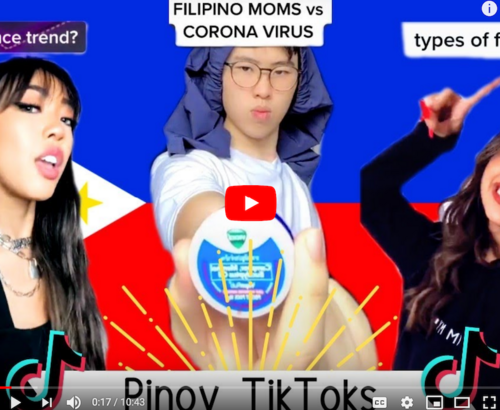“Ony Filipinos can Relate” : YouTube, TikTok and Compilation Videos

"Ony Filipinos can Relate" : YouTube, TikTok and Compilation Videos
On YouTube, some of the most popular videos are compilations of content posted on other social media platforms. Vine and TikTok compilations regularly gather if not millions of views, at least a few tens of thousands. A popular brand of compilation videos are ones related to cultural idiosyncrasies. Filipinos are very much part of this trend. On YouTube there are dozens of viral TikTok compilations related to Filipino culture. Most videos are some variation of the following titles: “Relatable Filipino TikToks”, “Only Filipinos can Relate”, “Funny Pinoy TikTok Compilation”.
One video from @torvas, captioned “Hey filipinos lets confuse everyone who isn’t filipino”, features him making air kisses, referencing the popular stereotype that Filipino adults point to things by pursing their lips. The humor of this video works only if one grasps the cultural context within which it functions. Without that context, as the caption references, the viewer will be “confuse[d]”. Another video from @jttantoco uses Pinglish, using the following phrases: “show respek ok?”, “bless tito boy bilisan ma” and “anak kiss tita baby”. A popular video from @noteven_ken uses the words lolas and titos. Without knowledge of Pinglish, these videos will not make sense to the viewer. Many videos had captions about confusing “non-filipinos” and how “if you know, you know”. Thus, as the title of the videos hint, “Only Filipinos can Relate”.
Most of the content featured in the compilation videos are made by Filipinos in the United States, most first-generation or second-generation. Probably because my searches were in English, I wasn’t able to find compilation videos made from content made in the Philippines. However, the content put out by the Filipino diaspora is no less important. The content they create reinforces nationalism and ideas of cultural independence in particularly interesting ways, especially when superimposed onto a social media landscape.
I often watch similar videos, only instead substitute in “Mexican” for “Filipino”. Laughing at these videos, knowing that my non-Mexican friends wouldn’t “get it” and thus not laugh, evoked great national pride in me. These videos could sometimes evoke as much fervor in me as Mexico-USA fútbol matches did. Even with Benedict Anderson’s edict that nations are imagined communities, shaped and constructed and dream, these compilation videos never fail to raise in me nationalist passions.
These compilation videos, such as the ones related to Filipino culture create interesting spaces of interaction on social media. On YouTube below the compilation videos there are long comment threads, mostly populated by members of the Filipino diaspora laughing together, sharing personal experiences and reviewing the accuracy of the content featured in the compilation. A virtual space is created for the Filipino diaspora, one which cannot be occupied by those unfamiliar with the cultural contexts within which these compilations function as funny and “relatable”. Thus, a pocket of cultural independence is claimed on social media.
https://www.youtube.com/watch?v=7yYA6VUHifw&t=5s
https://www.youtube.com/watch?v=1_kWrGtGpMU&t=7s
https://www.youtube.com/watch?v=N8B_1I7GgxE&t=1s
https://www.youtube.com/watch?v=uxMJRouHAWI&t=17s
https://www.youtube.com/watch?v=I-ug7FVb07M
Author: Dylan Carlson Sirvent León
Comments
Dylan,
Wonderful post! I finally understand tik tok. It’s the modern day equivalent of best goal compilations!
here is one for you, the great Hugo Sanchez:
https://www.youtube.com/watch?v=JhcBajLhuoU
But of course, nationalism runs deep. Benedict Anderson really should have had an additional chapter after Census, Map, Museum– it could have been called Tik Tok, World Cup Goals, and Inside Jokes.
Pages